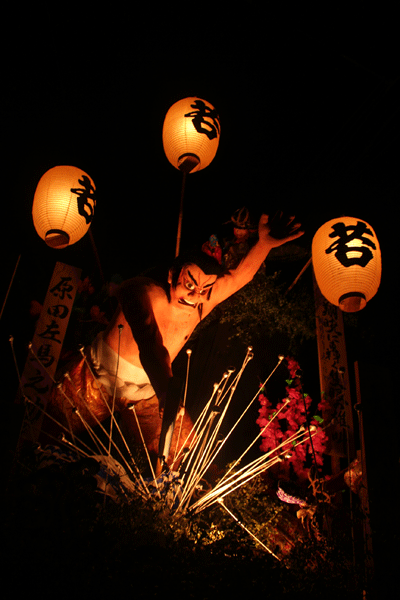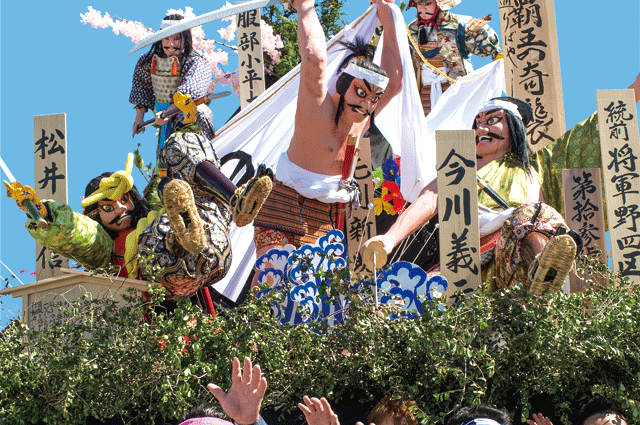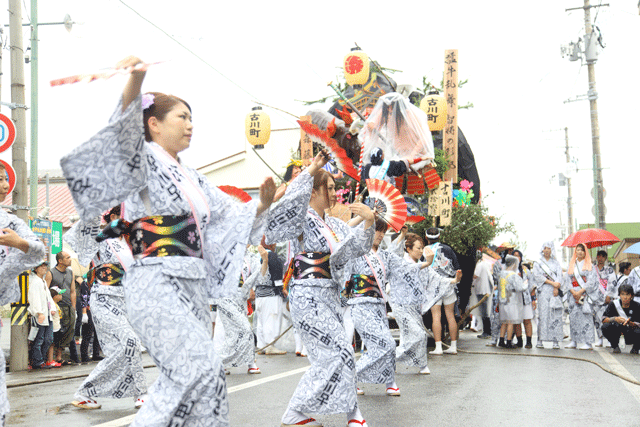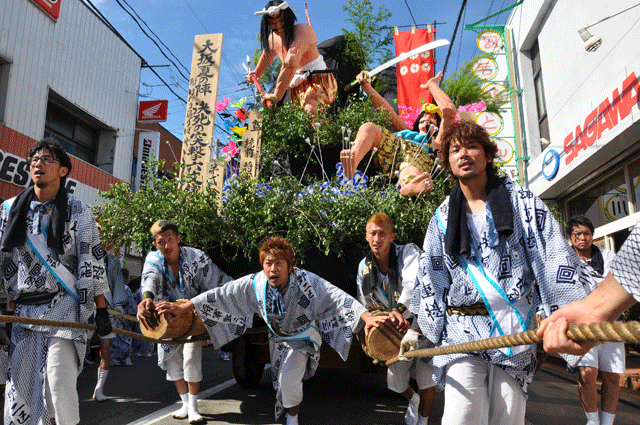Generations past come to vibrant life on the rolling stages of this Akita festival.
The Tsuchizaki Hikiyama Festival is a raucous celebration, appeasing the gods and cementing communities with shouting, towering festival floats, dance, and . . . dolls.
These are not any ordinary figures though. Standing high on the hikiyama floats are larger-than-life warriors straight from Japan’s Sengoku Jidai (Warring States Period), a time when samurai houses were in a constant struggle for supremacy and survival. Eternally locked in a single pose, about to strike or deflect a final blow, eyes gleaming and faces contorted with the rage of battle, the figures are frighteningly vicious. It appears that their battle until now has not been the graceful face-off of a samurai film, but a fierce and frantic struggle for life. There is something very primal about the figures. They reflect a time when warfare was the norm, before Japan was unified and peace led the samurai to pursue the arts as diligently as war.
Although the figures themselves are static, the chanting of the hikiyama bearers, the drummers and musicians riding in the back of the floats, and the crowds cheering in the streets give the scenes a sense of motion. Moving through the streets, powered by the energy and imagination of the crowd, the warriors come to life, the outcome of the many rolling battles left to the mind of each spectator.
Pulling the Mountains to Life
Every year, for two days in late July, hikiyama (literally, “pulled mountains”)—the large, warrior-bearing festival floats—are pulled out from neighborhoods throughout Tsuchizaki. Accompanied by music, dance, chanting, and general revelry, the hikiyama make their way towards the port, and Tsukizaki Shinmeisha Shrine. Spectators line the parade route on Honmachi Dori, waiting in anticipation, enjoying a drink or snacks from one of the many festival stalls. As the hikiyama approach to the sound of music—and the yells and chants of the carriers—the crowd joins in, swept up by the energy of the float-bearers, musicians, dancers, and most of all, by the sight of the giant warriors brought to life by the magic of the event.
Since being designated as an Important Intangible Folk Cultural Property in 1997, the Tsuchizaki Shinmeisha Hikiyama Matsuri has drawn in more and more people from all over Japan. Even so, many of the faces in the crowd are locals—if not of Tsuchizaki, then of other parts of Akita City and its surroundings. Some of them remember seeing the hikiyama as children, of being equally amazed and frightened by the fearsome warriors. Even to a casual tourist, the festival feels different than many of the larger parades in big cities.

With the tallest reaching as high as 15 meters tall, the floats are impressive works of art. In the front is the diorama. Each float is different but each one recreates dramatic scenes of two to three giant warriors locked in battle against a backdrop of trees, mountains or towering cliffs. Some of the combatants are two muscular hadaka ningyo—warriors with nothing but loincloths and weapons. Other floats have regally clothed musha ningyo—usually famous historical figures.
The back of the float presents a dramatically different scene. Standing at the top, looking out over the crowds behind is the mikaeshi ningyo. In a stark contrast to the warriors on the front of the float, the mikaeshi ningyo is a comical figure, often an old man in a summer yukata standing next to a tall signboard painted with a witty phrase. In the space below are the musicians. Each float has its own hanayashi, an ensemble of traditional Japanese musicians. The melodies of shamisen and kagura flute are backed by the rhythm of kotuzumi and taiko drums. In a time when even many traditional festivals rely on recorded music, seeing each float go by with its own band is impressive.
All of this is mounted on a framework constructed over the two thick poles stretching out over the wheel axles. Thick ropes, entwined in a complicated pattern, hold everything together. There are no brakes, no complicated steering. The leaders of each group have only their skill and years of experience with which to direct the team of float bearers. To a passing tourist, the teams chants and yells may look like an expression of their highspirits, but much of the noise is commands for steering, synchronizing the group’s movements.
The Warriors Return Home
As night falls, it is time for the hikiyama and its frozen warriors to go back. The return, known as the Modoriyama, is when the festivities reach their peak. The hikiyama is reversed, pulled backwards with the mikaeshi ningyo overseeing the safe return. The warriors, their battles all but forgotten, now take a back seat to the people pulling the float, the musicians, and revelers all around. The procession slowly moves away, stopping every so often to rouse the crowd with music and shouting. Eventually the groups split off, heading back to their own neighborhoods—many of the festivities will last well past midnight. By morning, the warriors will be still once again, awaiting their chance to emerge and do battle in the coming year.
Communities Connected by a Festival
Most matsuri are, after all, about celebrating, strengthening, and preserving community and tradition, and the Hikiyama Matsuri is a perfect example of the far-reaching impact this event can have. Without it, the last maker of these stunning warrior figures would have long since closed up shop and become just one more story of a lost craft.
But if the festival is not just a show of museum pieces or a reason to keep artisans in business. Other than the makers of the ningyo, nearly every aspect of the Hikiyama Matsuri is organized by regular members of the community. Once a year, regular people in each neighborhood transform into dancers, musicians, and float bearers. Preparations begin long in advance. Within the loose framework of the festival, each neighborhood creates its own original uniforms and dances. Unlike the portable mikoshi shrines used in many festivals, the hikiyama are largely made by regular people in the neighborhood. Guided by experienced residents, people in the community come together to build and decorate the colorful floats.
On the day of the festival, what started out as planks of wood and cloth has been transformed into a dramatic diorama. For one weekend, everyday workers, students, and housewives transform into float bearers, dancers, and musicians. But it is all the days of community work, planning, and preparation that matter most.
Sponsored Post











